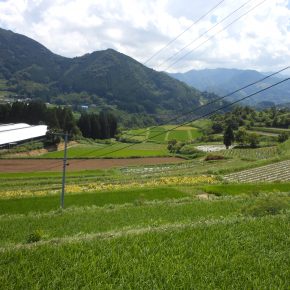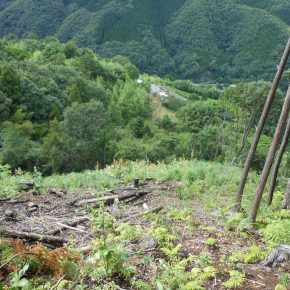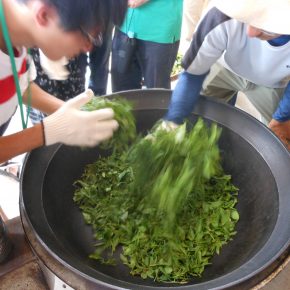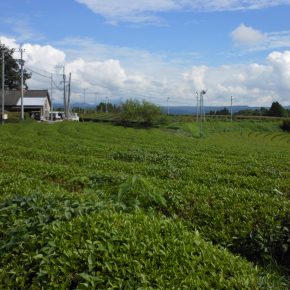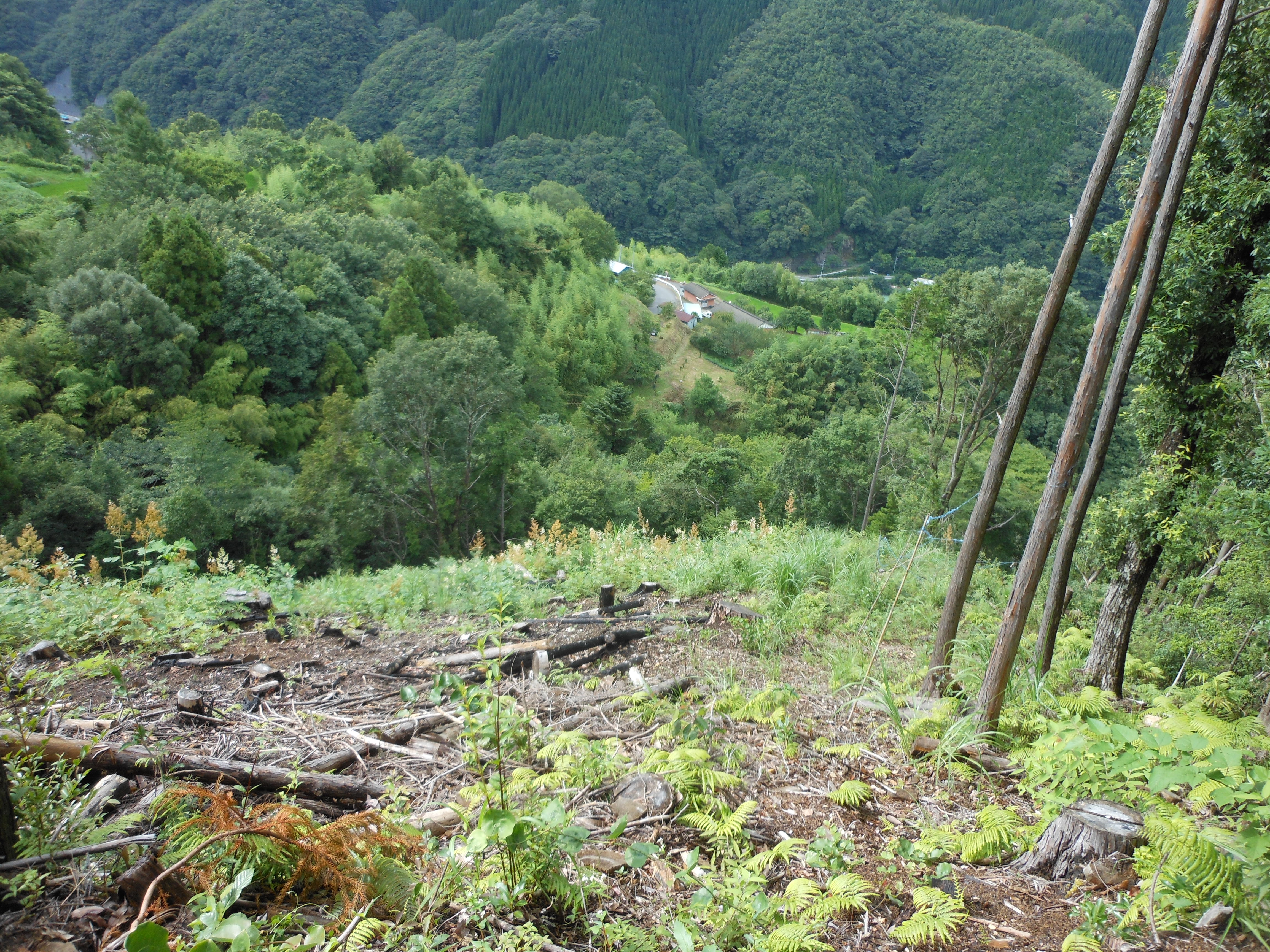
by Keigo Nishio
[divider]
[dropcap]A[/dropcap]fter a two hour drive from Kumamoto Airport, I reached an unexplored village. Surrounded by deep mountains from every quarter, the village was secluded from urban areas. Copses, rivers, flumes, and thatched houses. Mesmerized by the landscape, I felt as though I had reached a utopia. I soaked in nostalgia: the village had everything that Japan had lost through its modernization.
Takachiho and Shiiba regions, located at the centre of Kyushu island (the western part of Japan), were designated as Globally Important Agricultural Heritage Systems (GIAHS) in 2015. The main reason the Food and Agricultural Organization (FAO) admired these regions is for their traditional systems of agricultural community and solidarity. Each village has autonomously adopted the best form of agriculture, taking economic, environmental, and customary factors into consideration, instead of relying upon the Japanese central government’s uniform initiative for agricultural modernization. Due to this local autonomy, the agricultural landscape differs from village to village. In Shiiba village, people engage in slash-and-burn agriculture established in the primitive (Jomon) period; however, on the opposite side of that village, residents have chosen rice farming and organized rice terraces and irrigation canals. The FAO appreciated this complexity of agricultural structure that local communities have developed by themselves.
Shiiba village is devoted to slash-and-burn agriculture. Although slash-and-burn cultivation is notorious for its negative impact on the environment and ecosystem, agriculture in Shiiba is in fact conducive to preserving its forests. In Shiiba, each family has its own mountain and burns a portion of the mountain every four years. Immediately after the burning, farmers plant buckwheat. In the following three years, they grow millet, adzuki beans, and soybeans in this order. Apart from crops, farmers grow vegetables like mooli, konjac, and perilla. They also grow shiitake mushrooms on logs in the winter, the agricultural off-season. While buckwheat and millet require fertility of the soil, adzuki and soybeans serve to recover the soil’s fertility; therefore, at the end of the four-year cultivation, the land becomes as productive as it was after the burning. Then, farmers burn another portion of the land, leaving their original farming land for around twenty years. During these thirty years, the land turns into a copse, further improving the land’s fertility and water-retention potential. Periodical burning creates an environment in which young and diverse trees can easily grow. In Shiiba, flat land is sparse, and farmers cultivate their farming land on steep slopes of the mountains. Accordingly, it is daunting for them to carry fertilizers to their farming land. Slash-and-burn agriculture saves them the difficulty of carrying fertilizers since plant and wood ash serves as a fertilizer. This system of shifting cultivation is the best way to strike a balance between achieving productive agriculture and preserving healthy forests.
When burning the forests, farmers must see to it that they burn down all the land they plan to cultivate but avoid burning other portions of the forests. This task is too much for a family to bear all by itself; therefore, residents form local associations and burn the forests collaboratively. Seven or eight residents, both male and female, burn the forests together in the morning and sow seeds of buckwheat in the afternoon of the same day.
After the village was designated as GIAHS, slash-and-burn agriculture has become its major tourist attraction. Nonetheless, it does not invest much in the tourist industry. According to Mr. Yoshimitsu Shiiba, a farmer in the village, approximately a hundred and twenty tourists come to see him burn the land each time. However, Mr. Shiiba does not care much about attracting visitors from outside the village. He explained that he must pass down the seeds of plants native to the village and traditional agricultural techniques that he inherited from older generations. For him, preserving traditional seed-raising and agricultural skills is more important than attracting tourists.
One reason the village avoids relying upon tourism is that it experienced the risk of yielding to outside trends and pressures. In the 1960s and 70s, when Japan marked an unprecedented economic growth, the village was exposed to a trend of switching from agriculture to forestry (growing conifers, especially Japanese cedars, which would be used as construction materials). Copses were turned into coniferous forests, and there was a time when only one family engaged in slush-and-burn agriculture. The land’s water-retention potential decreased, and since Japanese cedars do not bear edible fruit, deer came down to farming land, and crops were seriously damaged. Not until these troubles came up did the villagers realize that their ancestors had developed traditions most-suited for preserving the environment and accomplishing sustainable lifestyles. These days, villages like Mr. Shiiba’s are forming communal organizations and working to revive the traditional form of agriculture.
Shiiba village is not the only place where residents are striving to keep their traditions alive. Gokase town is another example of local communities defending their traditions against outside forces. One of Gokase’s special products is Kamairi-cha, green tea fired in hot kilns using Chinese traditional techniques. Although ninety-nine percent of Japanese green tea is produced through steaming, the town sticks to its Kamairi tradition. Mr. Akira Miyazaki is one of the leading figures in Kamairi-cha manufacture who has won nationwide green tea awards. He admitted that his factory was exposed to a pressure from consumers all over the country who demanded that he make tea which tastes like common steamed green tea. However, he never surrendered to this pressure: he said that his tea plants have evolved to suit perfect organic farming and Kamairi production. According to him, even if he installed tea plants from outside suitable for steamed green tea, such plants would never grow well. He persists in Kamairi-cha to preserve his native tea plant and perfect organic agriculture. In order to preserve the Kamairi tradition, he increased the variety of Kamairi-cha: he sells not only green tea but also black and oolong tea produced through Kamairi. Respect for traditions has been the source of the village’s autonomy and creativity.
In contrast to Shiiba and Gokase, Takachiho town chose rice growing. Although rice is the symbol of Japan’s agricultural modernization, Takachiho’s choice does not signify deference to the national, totalitarian tendency to praise rice agriculture. Takachiho did not attempt to shift Shiiba’s agriculture from slush-and-burn to rice farming even though these two communities have interacted with one another. Takachiho’s determination is an exercise of local autonomy, as was the case with Shiiba and Gokase.
Since long ago, Takachiho has maintained a spiritual relationship with the Japanese central government because Takachiho is known as the first place on earth where the gods in Japan’s creation mythology landed when they came down from Heaven. Accordingly, Takachiho interacted with the central government and took part in the nationwide commodity economy much earlier than other villages, so farmers in the town determined to grow rice and sell it outside the town approximately 120 years ago. However, due to the town’s mountainous topography, they were unable to cultivate vast paddy fields. Therefore, to make the best use of their limited ground, they organized rice terraces and flumes, which are about 500 kilometres long all by themselves. When the town reformed the flumes after World War II, residents voluntarily took part in Ize-yakume, community service in the flumes, and even women carried cement that weighed up to sixty kilograms. Even today, this local solidarity is still strong: residents in the town constitute land-improvement associations and serve to maintain the flume systems. People are willing to pass down the maintenance skills to younger generations; for instance, they created a large poster with photographs to show how they have constructed and reformed rice fields and flumes. A farmer in the town recalled that such efforts had backed up the town’s designation as GIAHS. In most parts of Japan, the loss of regional cooperation has been a serious problem, so Takachiho’s agriculture is a good role model in considering how to revive and maintain regional solidarity.
Although villages in the regions have adopted different forms of agriculture, they share the commonality that residents respect and are striving to preserve their traditions. Their efforts are grounded upon their spiritual beliefs. People in the regions believe that crops are the gifts from the gods and that the relationship between the gods and humans must be kept unchanged even if human society is transforming. Every time the Shiiba villagers burn their forests, they make offerings to the gods and recite prayers. In Takachiho, people perform Yo-kagura, which is a thanksgiving ceremony held at night where farmers put on divine-like costumes and masks and dedicate dance to the gods. The costumes and masks make it possible for the farmers to bear and unite with the gods, as the representatives of the residents. Since the farmers maintain a belief that their traditional agriculture is the best means for receiving natural blessings from the gods, they have protected their traditions from the pressures of modernization until today.
The villagers’ respect for the traditions may imply that they are conservative and exclusive. Nonetheless, they are remarkably open to outsiders. Mr. Shiiba, a farmer in Shiiba village, told me that he would welcome newcomers. A Kagura-performer in Takachiho said, “Whoever can perform Kagura in the traditionally established way may join Yo-kagura even if that person was not born in the village.” This combination of traditionalism and openness seems to be key in each village’s sustainability.
But why, if these regions do not want to be exposed to outside forces, did they choose to apply for the GIAHS designation process? According to Mr. Tomonori Tasaki, a Takachiho town official in charge of GIAHS-related tasks, GIAHS is an opportunity for local farmers to recognize the value of their agriculture. He thinks that agriculture is so interwoven into their everyday lives that they do not realize how valuable and precious their agricultural systems are. For instance, a high school student I interviewed said, “My parents do not urge me to stay in the village or to take over agriculture since one cannot make much money through agriculture these days.” If the locals do not realize the preciousness of their agriculture, Mr. Tasaki fears, agricultural traditions and skills will be lost in the future. He aims to encourage the locals to find values of their everyday lives by demonstrating how their agriculture is appreciated by international experts from an academic viewpoint. He emphasizes that his town spends most of its GIAHS-related budget for domestic purposes, instead of tourist attraction. He anticipates that the designation as GIAHS will enable the locals to realize that their agriculture has value that must not be lost or changed.
Mr. Tasaki also hopes that the designation as GIAHS will lead youths to have pride and a sense of ownership in their local communities. One of the main aims of GIAHS is to hand down agricultural traditions and skills to younger generations. In order to increase opportunities to learn about local agriculture, the GIAHS Takachihogo-Shiibayama Site Revitalization Committee has partnered with Talachiho High School and the University of Miyazaki. Schools in Takachiho and Shiiba regions have classes which focus on the development of local agricultural systems. Some high school students, too, are reporting at the Takachiho-go Taberu Tsushin (Takachiho-go Food Journal): they interview local farmers and publish articles in the quarterly journal. Since Mr. Tasaki, born in Takachiho, was once working in Tokyo and Australia and returned to his hometown as he rediscovered the merits of Takachiho, he is all the more enthusiastic about conveying local values to his younger generations. Local youths are positively responding to these initiatives. Many of the high school students I interviewed in Gokase and Takachiho said that they would like to return to and serve their hometown even if they have to temporarily leave their villages to go to college.
The Takachiho and Shiiba regions are known as the birthplace of Japanese folkloristics. In 1908, Kunio Yanagita, Japan’s first folklorist, visited Shiiba village and saw local, unique traditions of slush-and-burn agriculture and hunting. Mesmerized, Yanagita then published Nochinokarikotobanoki, Japan’s first book based on folkloristic fieldwork. What fascinated Yanagita 110 years ago is still alive even today. Locals in Takachiho and Shiiba regions have developed their agricultural traditions and skills based on local autonomy and solidarity. Since they have never yielded to the pressures of modernization from outside, they have led a lifestyle that is the most sustainable way to coexist with nature. Behind the beautiful landscapes lie the locals’ efforts to preserve their unique agricultural history.
[hr]
Keigo Nishio is a sophomore in Branford College. You can contact him at keigo.nishio@yale.edu.
